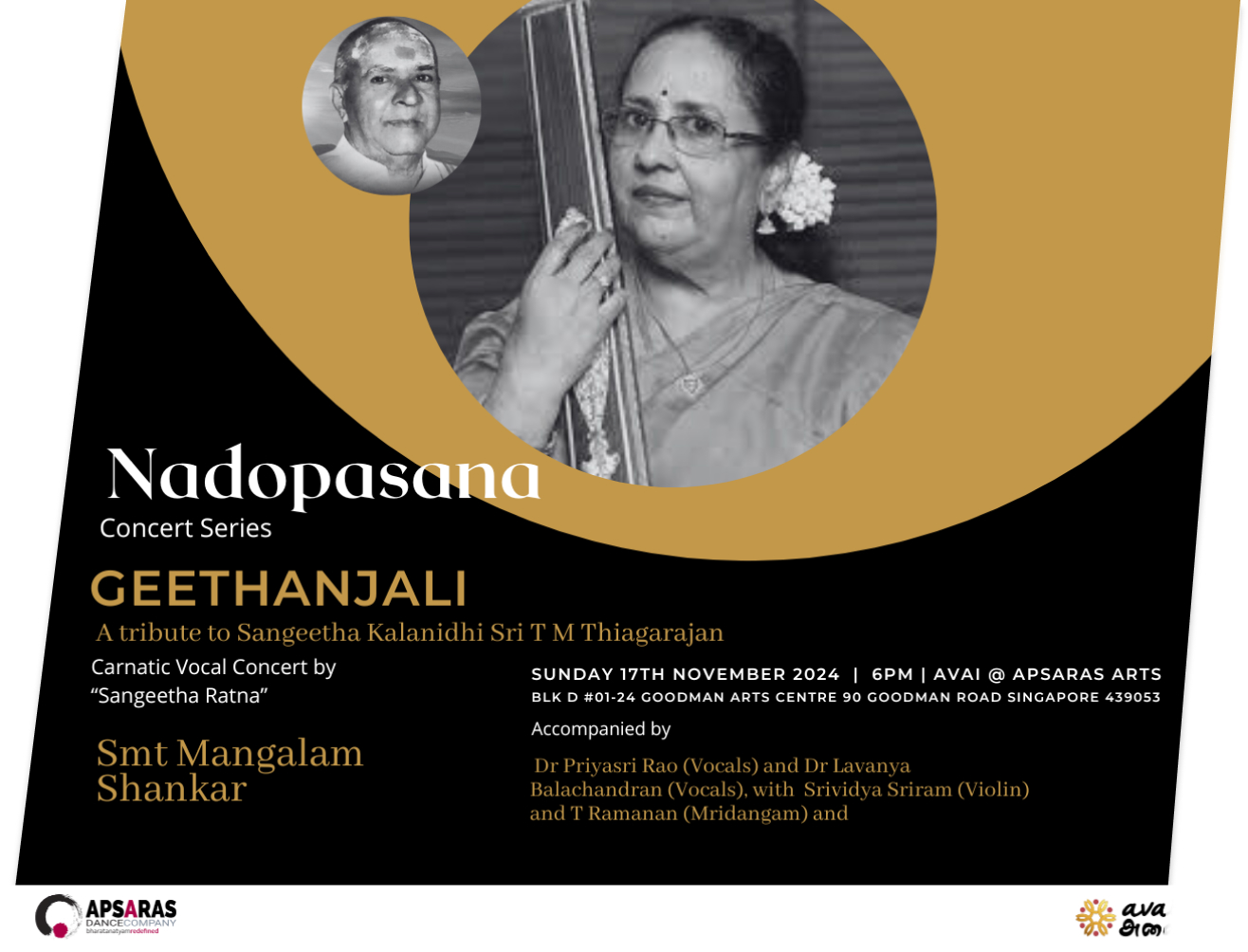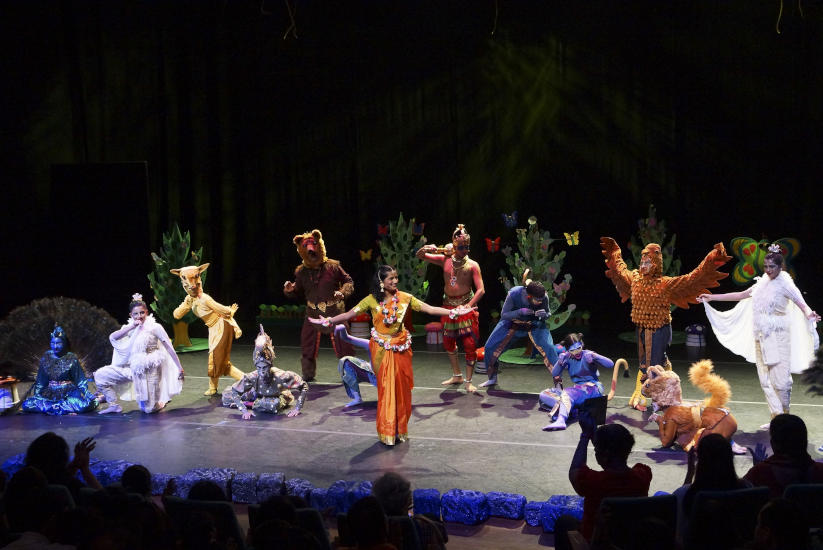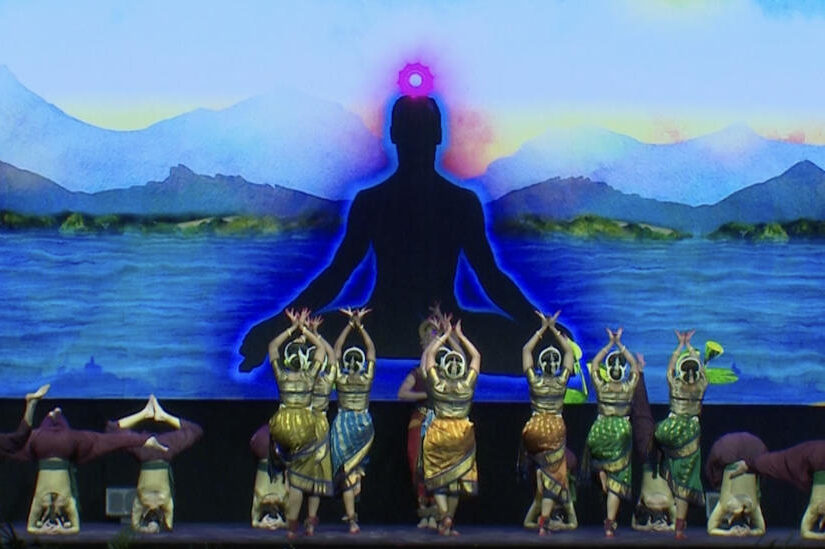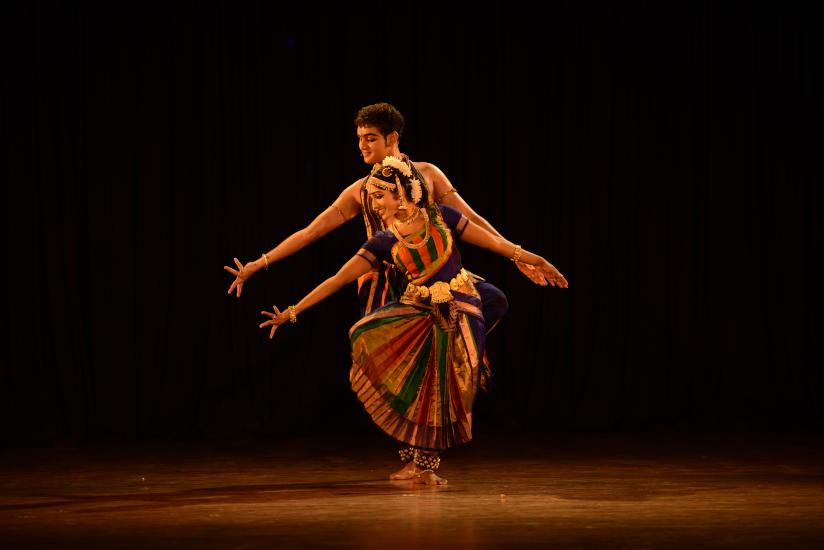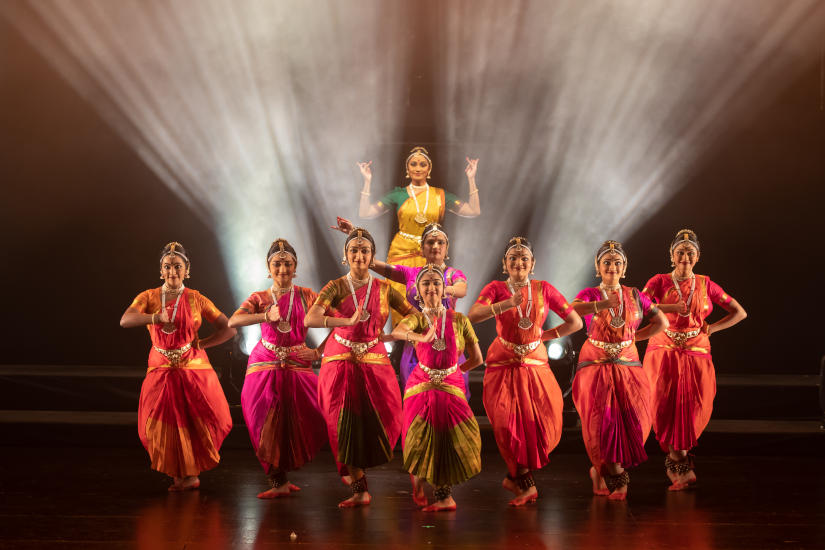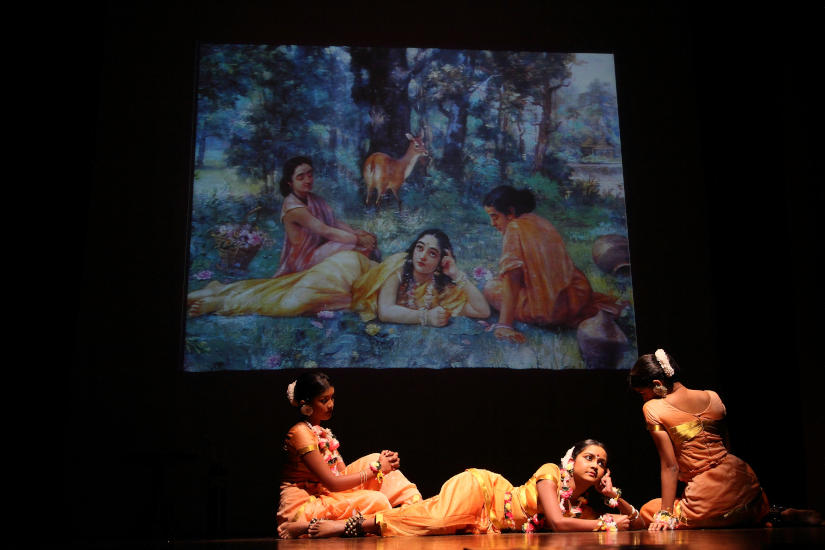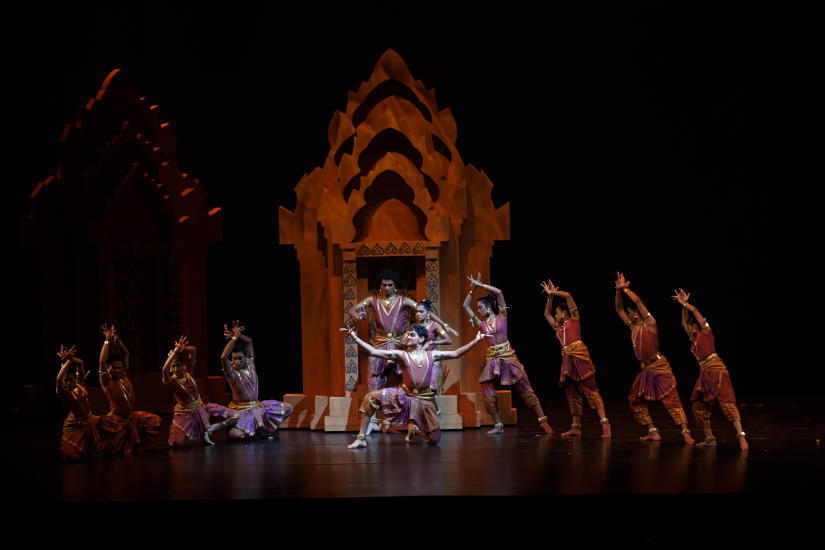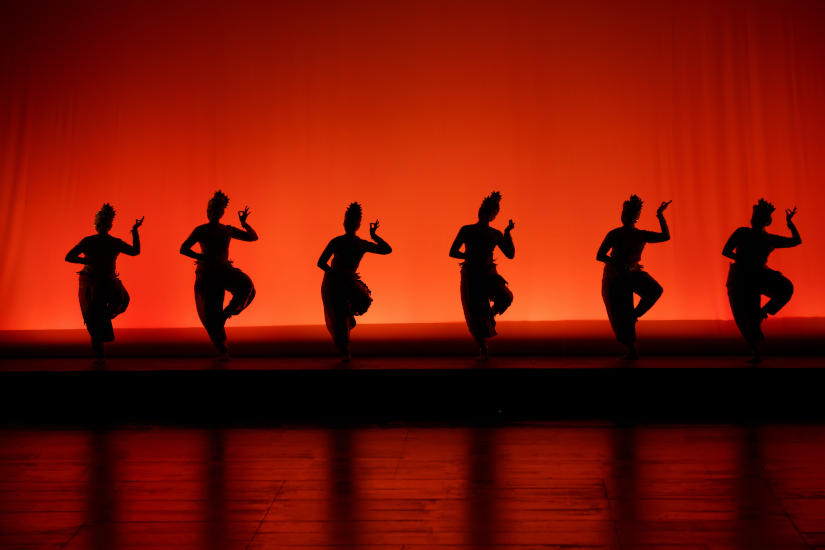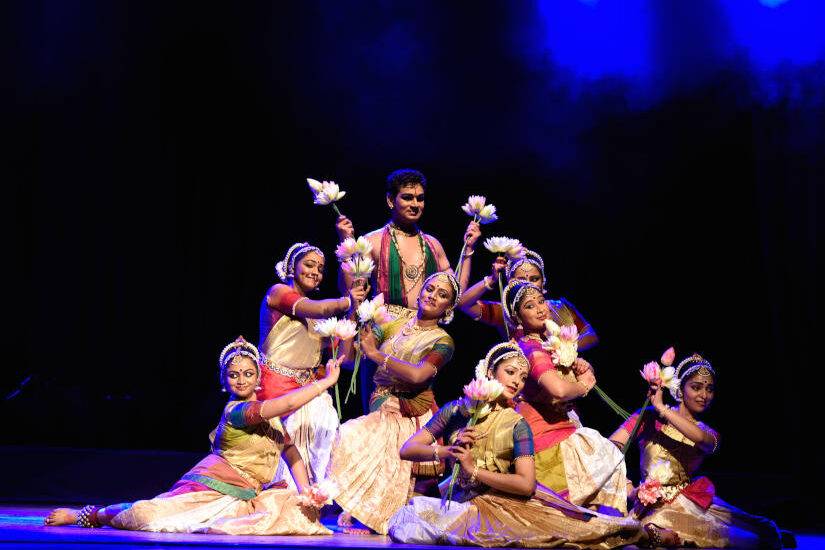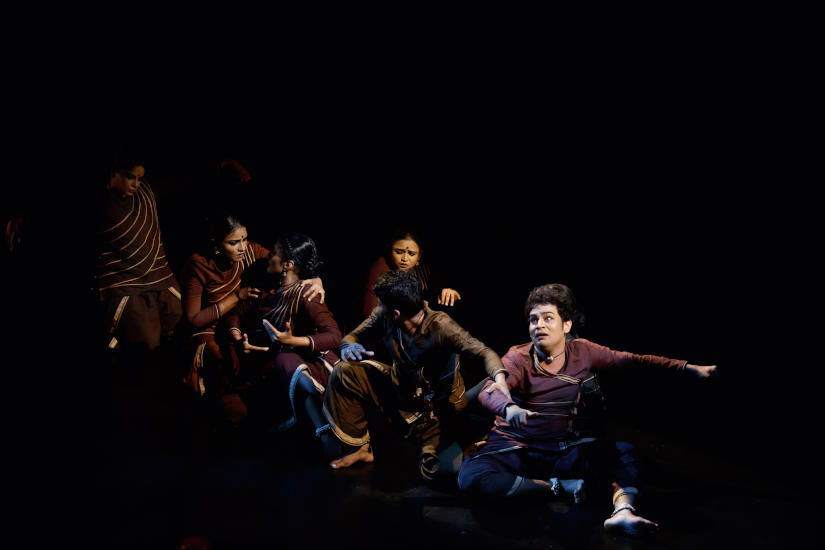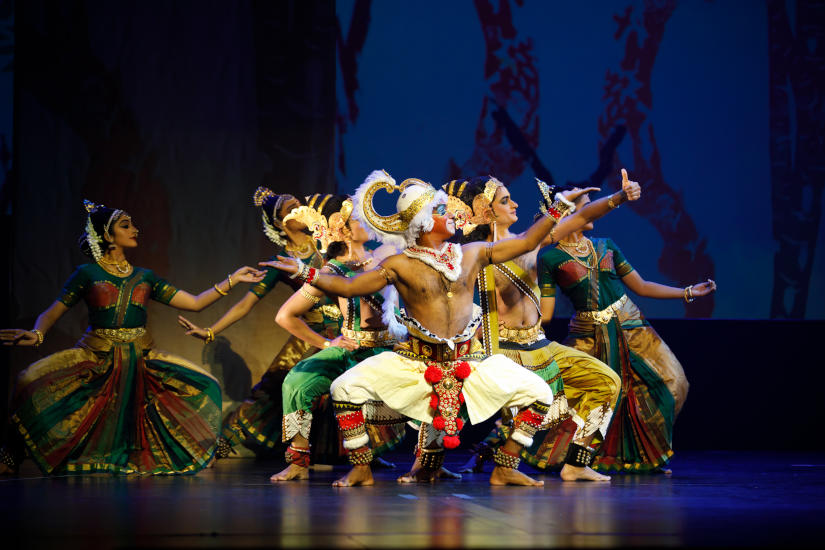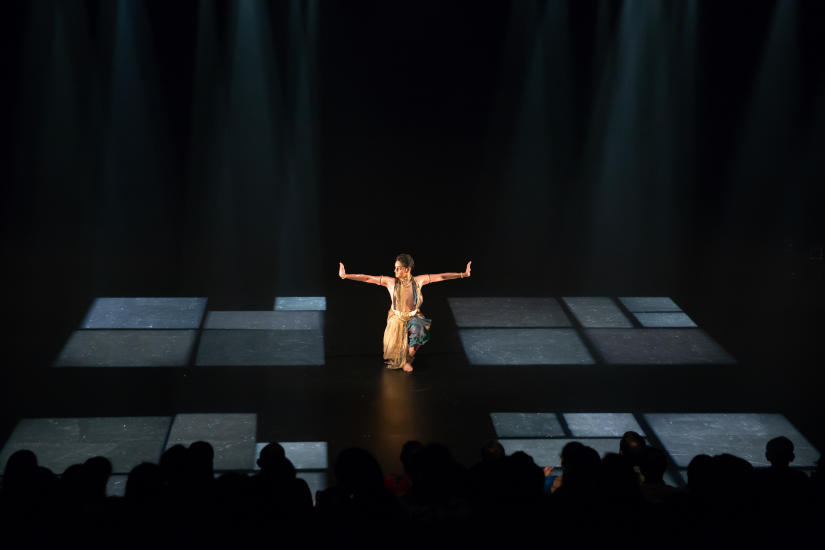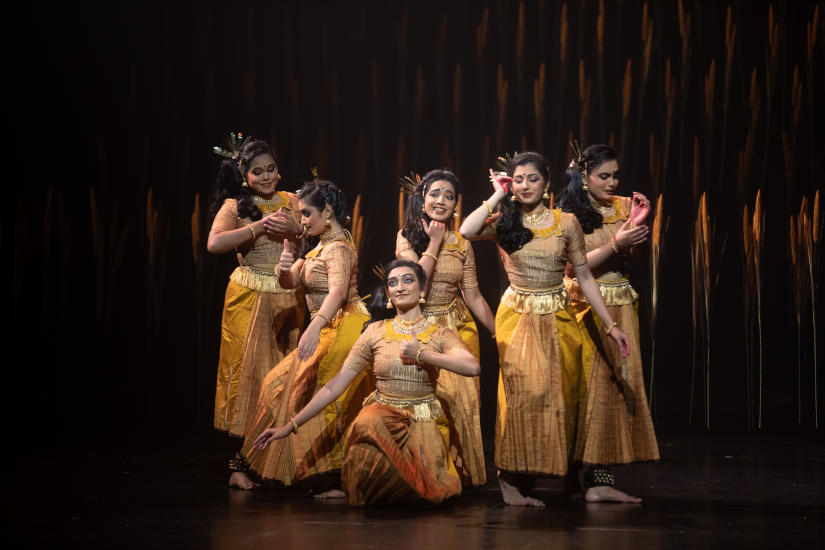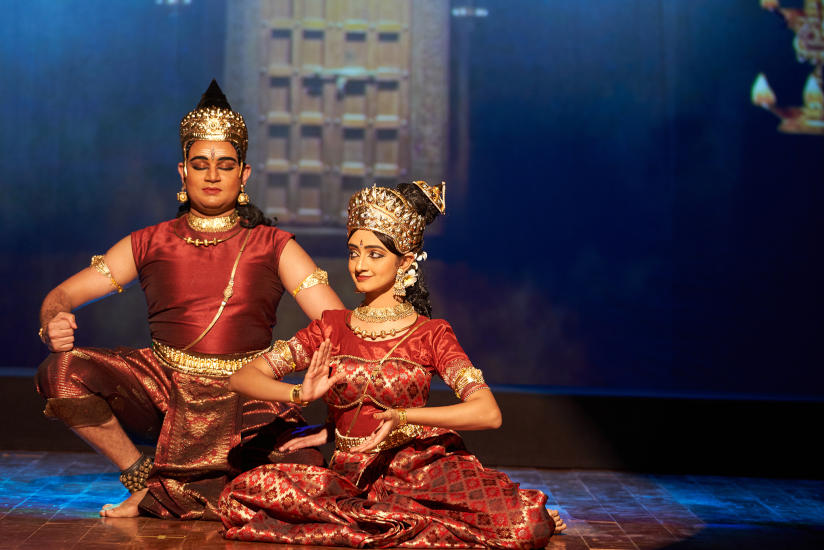@ApsarasDanceCompany
Repertoire
The Best of Apsaras Past Productions
A dance company is only as good as its last production. For Apsaras Dance Theatre, every “last production” has been a critically-acclaimed, audience-enthralling hit. Each production has been innovative, creative and unexpected. An artistic blend of the contemporary and tradition.
Synopsis
Sita’s Magical Forest is dance-theatre production, with a blend of contemporary and classical choreography, designed for young children audiences.
Readapted from the celebrated Ramayana epic, Sita, the heroine of the Ramayana, tells her children tales of war, bravery, friendship, loyalty and devotion, through adventures with the animals she met in the forest. Amongst them are an eagle; a bear; a sea monster; a squirrel; a golden deer; one of the most important characters, Hanuman, and his band of monkeys.
Synopsis
Sita’s Magical Forest is dance-theatre production, with a blend of contemporary and classical choreography, designed for young children audiences.
Readapted from the celebrated Ramayana epic, Sita, the heroine of the Ramayana, tells her children tales of war, bravery, friendship, loyalty and devotion, through adventures with the animals she met in the forest. Amongst them are an eagle; a bear; a sea monster; a squirrel; a golden deer; one of the most important characters, Hanuman, and his band of monkeys.
Synopsis
Sita’s Magical Forest is dance-theatre production, with a blend of contemporary and classical choreography, designed for young children audiences.
Readapted from the celebrated Ramayana epic, Sita, the heroine of the Ramayana, tells her children tales of war, bravery, friendship, loyalty and devotion, through adventures with the animals she met in the forest. Amongst them are an eagle; a bear; a sea monster; a squirrel; a golden deer; one of the most important characters, Hanuman, and his band of monkeys.
Synopsis
Sita’s Magical Forest is dance-theatre production, with a blend of contemporary and classical choreography, designed for young children audiences.
Readapted from the celebrated Ramayana epic, Sita, the heroine of the Ramayana, tells her children tales of war, bravery, friendship, loyalty and devotion, through adventures with the animals she met in the forest. Amongst them are an eagle; a bear; a sea monster; a squirrel; a golden deer; one of the most important characters, Hanuman, and his band of monkeys.
Synopsis
Anushasanam – The cosmic flow of yoga is a dance and yoga performance depicting the benefits of the practice of Yoga in awakening the energies that lie in the seven chakras of the human body. Each chakra opening is symbolised with the blooming of a lotus flower with different number of petals. The lotus with thousand petals represents the Sahasrara chakra at the crown of the head, which opens when a yogi attains mastery, wisdom and enlightenment.
Synopsis
Anushasanam – The cosmic flow of yoga is a dance and yoga performance depicting the benefits of the practice of Yoga in awakening the energies that lie in the seven chakras of the human body. Each chakra opening is symbolised with the blooming of a lotus flower with different number of petals. The lotus with thousand petals represents the Sahasrara chakra at the crown of the head, which opens when a yogi attains mastery, wisdom and enlightenment.
Synopsis
Anushasanam – The cosmic flow of yoga is a dance and yoga performance depicting the benefits of the practice of Yoga in awakening the energies that lie in the seven chakras of the human body. Each chakra opening is symbolised with the blooming of a lotus flower with different number of petals. The lotus with thousand petals represents the Sahasrara chakra at the crown of the head, which opens when a yogi attains mastery, wisdom and enlightenment.
Synopsis
Anushasanam – The cosmic flow of yoga is a dance and yoga performance depicting the benefits of the practice of Yoga in awakening the energies that lie in the seven chakras of the human body. Each chakra opening is symbolised with the blooming of a lotus flower with different number of petals. The lotus with thousand petals represents the Sahasrara chakra at the crown of the head, which opens when a yogi attains mastery, wisdom and enlightenment.
Synopsis
Aadum Arul Jothi – Dances of Divinity is a journey exploring the divine dance of the Hindu deities. The iconic image of Shiva Nataraja in the form as the eternal dancer enshrined in the temple of Chidambaram, South India, the divine dance of goddess Shakthi, and the worship of Krishna’s dance on the hood of the serpent Kalinga, are examples of this unique faith of the Hindus celebrating their Gods and Goddesses as divine dancers.
Synopsis
Aadum Arul Jothi – Dances of Divinity is a journey exploring the divine dance of the Hindu deities. The iconic image of Shiva Nataraja in the form as the eternal dancer enshrined in the temple of Chidambaram, South India, the divine dance of goddess Shakthi, and the worship of Krishna’s dance on the hood of the serpent Kalinga, are examples of this unique faith of the Hindus celebrating their Gods and Goddesses as divine dancers.
Synopsis
Aadum Arul Jothi – Dances of Divinity is a journey exploring the divine dance of the Hindu deities. The iconic image of Shiva Nataraja in the form as the eternal dancer enshrined in the temple of Chidambaram, South India, the divine dance of goddess Shakthi, and the worship of Krishna’s dance on the hood of the serpent Kalinga, are examples of this unique faith of the Hindus celebrating their Gods and Goddesses as divine dancers.
Synopsis
Aadum Arul Jothi – Dances of Divinity is a journey exploring the divine dance of the Hindu deities. The iconic image of Shiva Nataraja in the form as the eternal dancer enshrined in the temple of Chidambaram, South India, the divine dance of goddess Shakthi, and the worship of Krishna’s dance on the hood of the serpent Kalinga, are examples of this unique faith of the Hindus celebrating their Gods and Goddesses as divine dancers.
Synopsis
The banyan: a legendary tree that can, by itself, grow into a sprawling forest of entwined branches, roots and canopy. The banyan tree stands for time immemorial — it is the grand tree of tradition, for its very roots that hang become yet another trunk that supports its vast sprawling branches. Like the banyan, Bharatanatyam, from its roots as an ancient temple dance, has spawned a vast body of styles.
The expansive world of Bharatanatyam is explored through the metaphor of the banyan tree in Aalam, a dance production that brings you on an odyssey of the history of the world-famous dance. Apsaras Arts Dance Company explores the evolution
of Bharatanatyam with dancers performing compositions that depict various styles of the Indian classical dance through the ages.
Synopsis
The banyan: a legendary tree that can, by itself, grow into a sprawling forest of entwined branches, roots and canopy. The banyan tree stands for time immemorial — it is the grand tree of tradition, for its very roots that hang become yet another trunk that supports its vast sprawling branches. Like the banyan, Bharatanatyam, from its roots as an ancient temple dance, has spawned a vast body of styles.
The expansive world of Bharatanatyam is explored through the metaphor of the banyan tree in Aalam, a dance production that brings you on an odyssey of the history of the world-famous dance. Apsaras Arts Dance Company explores the evolution
of Bharatanatyam with dancers performing compositions that depict various styles of the Indian classical dance through the ages.
Synopsis
The banyan: a legendary tree that can, by itself, grow into a sprawling forest of entwined branches, roots and canopy. The banyan tree stands for time immemorial — it is the grand tree of tradition, for its very roots that hang become yet another trunk that supports its vast sprawling branches. Like the banyan, Bharatanatyam, from its roots as an ancient temple dance, has spawned a vast body of styles.
The expansive world of Bharatanatyam is explored through the metaphor of the banyan tree in Aalam, a dance production that brings you on an odyssey of the history of the world-famous dance. Apsaras Arts Dance Company explores the evolution
of Bharatanatyam with dancers performing compositions that depict various styles of the Indian classical dance through the ages.
Synopsis
The banyan: a legendary tree that can, by itself, grow into a sprawling forest of entwined branches, roots and canopy. The banyan tree stands for time immemorial — it is the grand tree of tradition, for its very roots that hang become yet another trunk that supports its vast sprawling branches. Like the banyan, Bharatanatyam, from its roots as an ancient temple dance, has spawned a vast body of styles.
The expansive world of Bharatanatyam is explored through the metaphor of the banyan tree in Aalam, a dance production that brings you on an odyssey of the history of the world-famous dance. Apsaras Arts Dance Company explores the evolution
of Bharatanatyam with dancers performing compositions that depict various styles of the Indian classical dance through the ages.
Synopsis
Though two very different disciplines, architecture
and dance share some commonalities in process and creation. Choreographers and architects, when creating new bodies of movement or conceptualising building infrastructures, always grapple the manipulation of space and light to construct new forms.
The dance production Nirmanika (‘architectonics’ in Sanskrit) explores the forms and aspects of architecture by deconstructing ancient monuments such as India’s Taj Mahal and Indonesia’s Borobudur through Bharatanatyam techniques such as nritta (movements) and abhinaya (expressions). Featuring six segments centered on geomancy, space, structure, philosophy, history and form, Nirmanika is ultimately about the beauty of architecture expressed through dance.
Synopsis
Though two very different disciplines, architecture
and dance share some commonalities in process and creation. Choreographers and architects, when creating new bodies of movement or conceptualising building infrastructures, always grapple the manipulation of space and light to construct new forms.
The dance production Nirmanika (‘architectonics’ in Sanskrit) explores the forms and aspects of architecture by deconstructing ancient monuments such as India’s Taj Mahal and Indonesia’s Borobudur through Bharatanatyam techniques such as nritta (movements) and abhinaya (expressions). Featuring six segments centered on geomancy, space, structure, philosophy, history and form, Nirmanika is ultimately about the beauty of architecture expressed through dance.
Synopsis
Though two very different disciplines, architecture
and dance share some commonalities in process and creation. Choreographers and architects, when creating new bodies of movement or conceptualising building infrastructures, always grapple the manipulation of space and light to construct new forms.
The dance production Nirmanika (‘architectonics’ in Sanskrit) explores the forms and aspects of architecture by deconstructing ancient monuments such as India’s Taj Mahal and Indonesia’s Borobudur through Bharatanatyam techniques such as nritta (movements) and abhinaya (expressions). Featuring six segments centered on geomancy, space, structure, philosophy, history and form, Nirmanika is ultimately about the beauty of architecture expressed through dance.
Synopsis
Though two very different disciplines, architecture
and dance share some commonalities in process and creation. Choreographers and architects, when creating new bodies of movement or conceptualising building infrastructures, always grapple the manipulation of space and light to construct new forms.
The dance production Nirmanika (‘architectonics’ in Sanskrit) explores the forms and aspects of architecture by deconstructing ancient monuments such as India’s Taj Mahal and Indonesia’s Borobudur through Bharatanatyam techniques such as nritta (movements) and abhinaya (expressions). Featuring six segments centered on geomancy, space, structure, philosophy, history and form, Nirmanika is ultimately about the beauty of architecture expressed through dance.
Synopsis
The Heroines of Raja Ravi Varma brings to life a selection of painted heroines through Bharatanatyam. This dance showcase explores the emotions portrayed in Raja Ravi Varma’s (1848–1906) 14 well-known paintings of Sita, Bhoomadevi, Damayanthi, Radha, Shakuntala and Yashodha. Known for their beauty, the lives of these heroines were filled with romance, love and tragedy.
Each enactment is accompanied by poetry from various genres and meticulously designed costumes that reflect the styles depicted in the paintings. The heroines’ stories come to life from the canvas, speaking through dance.
Synopsis
The Heroines of Raja Ravi Varma brings to life a selection of painted heroines through Bharatanatyam. This dance showcase explores the emotions portrayed in Raja Ravi Varma’s (1848–1906) 14 well-known paintings of Sita, Bhoomadevi, Damayanthi, Radha, Shakuntala and Yashodha. Known for their beauty, the lives of these heroines were filled with romance, love and tragedy.
Each enactment is accompanied by poetry from various genres and meticulously designed costumes that reflect the styles depicted in the paintings. The heroines’ stories come to life from the canvas, speaking through dance.
Synopsis
The Heroines of Raja Ravi Varma brings to life a selection of painted heroines through Bharatanatyam. This dance showcase explores the emotions portrayed in Raja Ravi Varma’s (1848–1906) 14 well-known paintings of Sita, Bhoomadevi, Damayanthi, Radha, Shakuntala and Yashodha. Known for their beauty, the lives of these heroines were filled with romance, love and tragedy.
Each enactment is accompanied by poetry from various genres and meticulously designed costumes that reflect the styles depicted in the paintings. The heroines’ stories come to life from the canvas, speaking through dance.
Synopsis
The Heroines of Raja Ravi Varma brings to life a selection of painted heroines through Bharatanatyam. This dance showcase explores the emotions portrayed in Raja Ravi Varma’s (1848–1906) 14 well-known paintings of Sita, Bhoomadevi, Damayanthi, Radha, Shakuntala and Yashodha. Known for their beauty, the lives of these heroines were filled with romance, love and tragedy.
Each enactment is accompanied by poetry from various genres and meticulously designed costumes that reflect the styles depicted in the paintings. The heroines’ stories come to life from the canvas, speaking through dance.
Synopsis
In a tale long lost to a forgotten past, two women’s lives intertwine, bound by devotion and fate. As their story resurfaces through dance, a grand and noble vision to build one of the most magnificent Hindu temples in the world is revealed.
Angkor: An Untold Story follows the Khmer queen Suryavana as she seeks to quench her king’s thirst for war. Convinced that the arts have the power to keep her absent king by her side, she sends her royal advisor to the distant Chola Empire to find learned artisans
to share their knowledge. The beautiful artisan Vyjayanti returns with him, brimming with passion and devotion to Lord Vishnu. The two are led down a path of conflict between mortal and divine love, and redemption.
Synopsis
In a tale long lost to a forgotten past, two women’s lives intertwine, bound by devotion and fate. As their story resurfaces through dance, a grand and noble vision to build one of the most magnificent Hindu temples in the world is revealed.
Angkor: An Untold Story follows the Khmer queen Suryavana as she seeks to quench her king’s thirst for war. Convinced that the arts have the power to keep her absent king by her side, she sends her royal advisor to the distant Chola Empire to find learned artisans
to share their knowledge. The beautiful artisan Vyjayanti returns with him, brimming with passion and devotion to Lord Vishnu. The two are led down a path of conflict between mortal and divine love, and redemption.
Synopsis
In a tale long lost to a forgotten past, two women’s lives intertwine, bound by devotion and fate. As their story resurfaces through dance, a grand and noble vision to build one of the most magnificent Hindu temples in the world is revealed.
Angkor: An Untold Story follows the Khmer queen Suryavana as she seeks to quench her king’s thirst for war. Convinced that the arts have the power to keep her absent king by her side, she sends her royal advisor to the distant Chola Empire to find learned artisans
to share their knowledge. The beautiful artisan Vyjayanti returns with him, brimming with passion and devotion to Lord Vishnu. The two are led down a path of conflict between mortal and divine love, and redemption.
Synopsis
In a tale long lost to a forgotten past, two women’s lives intertwine, bound by devotion and fate. As their story resurfaces through dance, a grand and noble vision to build one of the most magnificent Hindu temples in the world is revealed.
Angkor: An Untold Story follows the Khmer queen Suryavana as she seeks to quench her king’s thirst for war. Convinced that the arts have the power to keep her absent king by her side, she sends her royal advisor to the distant Chola Empire to find learned artisans
to share their knowledge. The beautiful artisan Vyjayanti returns with him, brimming with passion and devotion to Lord Vishnu. The two are led down a path of conflict between mortal and divine love, and redemption.
Synopsis
In this sequel to Nirmanika — The Beauty of Architecture by Apsaras Arts, Añjasa explores the beauty of Buddhist temple architecture. The audience will journey through monuments such as Mahadevi Temple in Nepal, Buddhagaya Maha Bodhi Temple and Sanchi Stupa in India, Vatadage in Sri Lanka, Shwedagon Pagoda in Yangon, Bayon in Cambodia, and the Borobudur in Indonesia.
This thematic dance presentation will also delve into Buddhist emperors Ashoka and Jayavarman VII, who were influential in the spread of Buddhism across Asia. Experience the wonders of Buddhist monuments through the expressions and movements of the classical dance style, Bharatanatyam.
Synopsis
In this sequel to Nirmanika — The Beauty of Architecture by Apsaras Arts, Añjasa explores the beauty of Buddhist temple architecture. The audience will journey through monuments such as Mahadevi Temple in Nepal, Buddhagaya Maha Bodhi Temple and Sanchi Stupa in India, Vatadage in Sri Lanka, Shwedagon Pagoda in Yangon, Bayon in Cambodia, and the Borobudur in Indonesia.
This thematic dance presentation will also delve into Buddhist emperors Ashoka and Jayavarman VII, who were influential in the spread of Buddhism across Asia. Experience the wonders of Buddhist monuments through the expressions and movements of the classical dance style, Bharatanatyam.
Synopsis
In this sequel to Nirmanika — The Beauty of Architecture by Apsaras Arts, Añjasa explores the beauty of Buddhist temple architecture. The audience will journey through monuments such as Mahadevi Temple in Nepal, Buddhagaya Maha Bodhi Temple and Sanchi Stupa in India, Vatadage in Sri Lanka, Shwedagon Pagoda in Yangon, Bayon in Cambodia, and the Borobudur in Indonesia.
This thematic dance presentation will also delve into Buddhist emperors Ashoka and Jayavarman VII, who were influential in the spread of Buddhism across Asia. Experience the wonders of Buddhist monuments through the expressions and movements of the classical dance style, Bharatanatyam.
Synopsis
In this sequel to Nirmanika — The Beauty of Architecture by Apsaras Arts, Añjasa explores the beauty of Buddhist temple architecture. The audience will journey through monuments such as Mahadevi Temple in Nepal, Buddhagaya Maha Bodhi Temple and Sanchi Stupa in India, Vatadage in Sri Lanka, Shwedagon Pagoda in Yangon, Bayon in Cambodia, and the Borobudur in Indonesia.
This thematic dance presentation will also delve into Buddhist emperors Ashoka and Jayavarman VII, who were influential in the spread of Buddhism across Asia. Experience the wonders of Buddhist monuments through the expressions and movements of the classical dance style, Bharatanatyam.
Synopsis
Representative of the abstract and the concrete universes, the lotus flower has held a sacred status since antiquity by Hindus, Egyptians and thereafter by Buddhists. It is revered in China and Japan, and adopted as a Christian emblem by the Greek and Latin Churches.
‘Alapadma’ refers to a fully opened lotus, and is the name of a dance mudra (hand gesture) as codified in ancient texts on Indian dance and theatre. Alapadma – The Lotus Unfolds is a Bharatanatyam dance production that draws inspiration from the multifaceted symbolism of the lotus. Dancers and musicians from Apsaras Arts explore the sacred flower’s representation in mythology, iconography and philosophy, particularly in the ancient civilisations of India, Egypt and Southeast Asia.
Synopsis
Representative of the abstract and the concrete universes, the lotus flower has held a sacred status since antiquity by Hindus, Egyptians and thereafter by Buddhists. It is revered in China and Japan, and adopted as a Christian emblem by the Greek and Latin Churches.
‘Alapadma’ refers to a fully opened lotus, and is the name of a dance mudra (hand gesture) as codified in ancient texts on Indian dance and theatre. Alapadma – The Lotus Unfolds is a Bharatanatyam dance production that draws inspiration from the multifaceted symbolism of the lotus. Dancers and musicians from Apsaras Arts explore the sacred flower’s representation in mythology, iconography and philosophy, particularly in the ancient civilisations of India, Egypt and Southeast Asia.
Synopsis
Representative of the abstract and the concrete universes, the lotus flower has held a sacred status since antiquity by Hindus, Egyptians and thereafter by Buddhists. It is revered in China and Japan, and adopted as a Christian emblem by the Greek and Latin Churches.
‘Alapadma’ refers to a fully opened lotus, and is the name of a dance mudra (hand gesture) as codified in ancient texts on Indian dance and theatre. Alapadma – The Lotus Unfolds is a Bharatanatyam dance production that draws inspiration from the multifaceted symbolism of the lotus. Dancers and musicians from Apsaras Arts explore the sacred flower’s representation in mythology, iconography and philosophy, particularly in the ancient civilisations of India, Egypt and Southeast Asia.
Synopsis
Representative of the abstract and the concrete universes, the lotus flower has held a sacred status since antiquity by Hindus, Egyptians and thereafter by Buddhists. It is revered in China and Japan, and adopted as a Christian emblem by the Greek and Latin Churches.
‘Alapadma’ refers to a fully opened lotus, and is the name of a dance mudra (hand gesture) as codified in ancient texts on Indian dance and theatre. Alapadma – The Lotus Unfolds is a Bharatanatyam dance production that draws inspiration from the multifaceted symbolism of the lotus. Dancers and musicians from Apsaras Arts explore the sacred flower’s representation in mythology, iconography and philosophy, particularly in the ancient civilisations of India, Egypt and Southeast Asia.
Synopsis
Agathi draws inspiration from Apsaras Arts Artistic Director Aravinth Kumarasamy’s own experience as a refugee in his youth, as well as the lives of refugee children all over the world. Boldly reimagined in collaboration with Wild Rice artistic director Ivan Heng, this production poignantly shines the spotlight on the people who find themselves caught between countries and trapped in the headlines.
Displaced for reasons of political turmoil or natural calamity, the refugee embarks on a journey to seek acceptance – rebuilding a life, a home and an identity, while battling prejudices and overcoming trauma. Agathi brings storytelling to new heights through a unique fusion of theatre, poetry and Bharatanatyam, the oldest classical dance tradition in India.
Synopsis
Agathi draws inspiration from Apsaras Arts Artistic Director Aravinth Kumarasamy’s own experience as a refugee in his youth, as well as the lives of refugee children all over the world. Boldly reimagined in collaboration with Wild Rice artistic director Ivan Heng, this production poignantly shines the spotlight on the people who find themselves caught between countries and trapped in the headlines.
Displaced for reasons of political turmoil or natural calamity, the refugee embarks on a journey to seek acceptance – rebuilding a life, a home and an identity, while battling prejudices and overcoming trauma. Agathi brings storytelling to new heights through a unique fusion of theatre, poetry and Bharatanatyam, the oldest classical dance tradition in India.
Synopsis
Agathi draws inspiration from Apsaras Arts Artistic Director Aravinth Kumarasamy’s own experience as a refugee in his youth, as well as the lives of refugee children all over the world. Boldly reimagined in collaboration with Wild Rice artistic director Ivan Heng, this production poignantly shines the spotlight on the people who find themselves caught between countries and trapped in the headlines.
Displaced for reasons of political turmoil or natural calamity, the refugee embarks on a journey to seek acceptance – rebuilding a life, a home and an identity, while battling prejudices and overcoming trauma. Agathi brings storytelling to new heights through a unique fusion of theatre, poetry and Bharatanatyam, the oldest classical dance tradition in India.
Synopsis
Agathi draws inspiration from Apsaras Arts Artistic Director Aravinth Kumarasamy’s own experience as a refugee in his youth, as well as the lives of refugee children all over the world. Boldly reimagined in collaboration with Wild Rice artistic director Ivan Heng, this production poignantly shines the spotlight on the people who find themselves caught between countries and trapped in the headlines.
Displaced for reasons of political turmoil or natural calamity, the refugee embarks on a journey to seek acceptance – rebuilding a life, a home and an identity, while battling prejudices and overcoming trauma. Agathi brings storytelling to new heights through a unique fusion of theatre, poetry and Bharatanatyam, the oldest classical dance tradition in India.
Synopsis
For centuries, the ancient Indian epic, the Ramayana, has captured the imagination of Asia with its universal themes of righteousness, love, loyalty and frailty. One of the most beloved characters in the story is the monkey god Hanuman, who plays a crucial role in Prince Rama’s quest to rescue his wife, Sita, from the demon king Ravana. Unfolding through dance and music, Anjaneyam follows the life and adventures of Hanuman and bears witness to the birth of the Ramayana when Hanuman encounters its author Maharishi Valmiki.
Co-produced by Apsaras Arts Dance Company and Esplanade – Theatres on the Bay, this cross-cultural production features an arresting juxtaposition of Indian and Southeast Asian depictions of the epic, told through Bharatanatyam and Javanese dance. It is set to a stirring, original score performed by Indian classical musicians from Singapore and India and Javanese musicians from Indonesia.
Synopsis
For centuries, the ancient Indian epic, the Ramayana, has captured the imagination of Asia with its universal themes of righteousness, love, loyalty and frailty. One of the most beloved characters in the story is the monkey god Hanuman, who plays a crucial role in Prince Rama’s quest to rescue his wife, Sita, from the demon king Ravana. Unfolding through dance and music, Anjaneyam follows the life and adventures of Hanuman and bears witness to the birth of the Ramayana when Hanuman encounters its author Maharishi Valmiki.
Co-produced by Apsaras Arts Dance Company and Esplanade – Theatres on the Bay, this cross-cultural production features an arresting juxtaposition of Indian and Southeast Asian depictions of the epic, told through Bharatanatyam and Javanese dance. It is set to a stirring, original score performed by Indian classical musicians from Singapore and India and Javanese musicians from Indonesia.
Synopsis
For centuries, the ancient Indian epic, the Ramayana, has captured the imagination of Asia with its universal themes of righteousness, love, loyalty and frailty. One of the most beloved characters in the story is the monkey god Hanuman, who plays a crucial role in Prince Rama’s quest to rescue his wife, Sita, from the demon king Ravana. Unfolding through dance and music, Anjaneyam follows the life and adventures of Hanuman and bears witness to the birth of the Ramayana when Hanuman encounters its author Maharishi Valmiki.
Co-produced by Apsaras Arts Dance Company and Esplanade – Theatres on the Bay, this cross-cultural production features an arresting juxtaposition of Indian and Southeast Asian depictions of the epic, told through Bharatanatyam and Javanese dance. It is set to a stirring, original score performed by Indian classical musicians from Singapore and India and Javanese musicians from Indonesia.
Synopsis
For centuries, the ancient Indian epic, the Ramayana, has captured the imagination of Asia with its universal themes of righteousness, love, loyalty and frailty. One of the most beloved characters in the story is the monkey god Hanuman, who plays a crucial role in Prince Rama’s quest to rescue his wife, Sita, from the demon king Ravana. Unfolding through dance and music, Anjaneyam follows the life and adventures of Hanuman and bears witness to the birth of the Ramayana when Hanuman encounters its author Maharishi Valmiki.
Co-produced by Apsaras Arts Dance Company and Esplanade – Theatres on the Bay, this cross-cultural production features an arresting juxtaposition of Indian and Southeast Asian depictions of the epic, told through Bharatanatyam and Javanese dance. It is set to a stirring, original score performed by Indian classical musicians from Singapore and India and Javanese musicians from Indonesia.
Synopsis
Parama Padam was created by followers of the Vaishnavite faith, with the dual purpose of entertainment and inculcating moral values. On the game board are a hundred squares illustrated with snakes and ladders, representing vices and virtues, respectively. Ladders allow you to ascend, just as good deeds pave the road to heaven, while snakes bring you down, like the cycle of rebirth. The final goal is to reach Vaikuntha, or Heaven. This game originated in India in the 10th century, and became popularised worldwide by the British as the classic game of Snakes and Ladders during the 18th century.
Synopsis
Parama Padam was created by followers of the Vaishnavite faith, with the dual purpose of entertainment and inculcating moral values. On the game board are a hundred squares illustrated with snakes and ladders, representing vices and virtues, respectively. Ladders allow you to ascend, just as good deeds pave the road to heaven, while snakes bring you down, like the cycle of rebirth. The final goal is to reach Vaikuntha, or Heaven. This game originated in India in the 10th century, and became popularised worldwide by the British as the classic game of Snakes and Ladders during the 18th century.
Synopsis
Parama Padam was created by followers of the Vaishnavite faith, with the dual purpose of entertainment and inculcating moral values. On the game board are a hundred squares illustrated with snakes and ladders, representing vices and virtues, respectively. Ladders allow you to ascend, just as good deeds pave the road to heaven, while snakes bring you down, like the cycle of rebirth. The final goal is to reach Vaikuntha, or Heaven. This game originated in India in the 10th century, and became popularised worldwide by the British as the classic game of Snakes and Ladders during the 18th century.
Synopsis
Parama Padam was created by followers of the Vaishnavite faith, with the dual purpose of entertainment and inculcating moral values. On the game board are a hundred squares illustrated with snakes and ladders, representing vices and virtues, respectively. Ladders allow you to ascend, just as good deeds pave the road to heaven, while snakes bring you down, like the cycle of rebirth. The final goal is to reach Vaikuntha, or Heaven. This game originated in India in the 10th century, and became popularised worldwide by the British as the classic game of Snakes and Ladders during the 18th century.
Synopsis
Communities across Asia are bound together by rice, described by many as the grain of life. Arisi: Rice is a cross-cultural and multidisciplinary production that pays homage to this reality. Taking the bold approach of eschewing traditional epic storytelling, Arisi is crafted as a series of vignettes about the rites and rituals honouring the various stages of life — birth, marriage, death — alongside the stages of rice cultivation. In each of these ceremonies marking the most significant moments in life, rice is the principal ingredient.
Arisi takes the audience through a kaleidoscope of dynamic images brought to life through bharatanatyam, with Apsaras Arts dancers sharing the stage with Balinese dancers from the GEOK Ensemble. And for the first time ever, the company collaborates with the Singapore Chinese Orchestra to create a truly unique score. A filmic layer of stories from Indian migrant workers who hail from a lineage of farming adds a powerful, first-person narrative to the dance production.
Synopsis
Communities across Asia are bound together by rice, described by many as the grain of life. Arisi: Rice is a cross-cultural and multidisciplinary production that pays homage to this reality. Taking the bold approach of eschewing traditional epic storytelling, Arisi is crafted as a series of vignettes about the rites and rituals honouring the various stages of life — birth, marriage, death — alongside the stages of rice cultivation. In each of these ceremonies marking the most significant moments in life, rice is the principal ingredient.
Arisi takes the audience through a kaleidoscope of dynamic images brought to life through bharatanatyam, with Apsaras Arts dancers sharing the stage with Balinese dancers from the GEOK Ensemble. And for the first time ever, the company collaborates with the Singapore Chinese Orchestra to create a truly unique score. A filmic layer of stories from Indian migrant workers who hail from a lineage of farming adds a powerful, first-person narrative to the dance production.
Synopsis
Communities across Asia are bound together by rice, described by many as the grain of life. Arisi: Rice is a cross-cultural and multidisciplinary production that pays homage to this reality. Taking the bold approach of eschewing traditional epic storytelling, Arisi is crafted as a series of vignettes about the rites and rituals honouring the various stages of life — birth, marriage, death — alongside the stages of rice cultivation. In each of these ceremonies marking the most significant moments in life, rice is the principal ingredient.
Arisi takes the audience through a kaleidoscope of dynamic images brought to life through bharatanatyam, with Apsaras Arts dancers sharing the stage with Balinese dancers from the GEOK Ensemble. And for the first time ever, the company collaborates with the Singapore Chinese Orchestra to create a truly unique score. A filmic layer of stories from Indian migrant workers who hail from a lineage of farming adds a powerful, first-person narrative to the dance production.
Synopsis
Communities across Asia are bound together by rice, described by many as the grain of life. Arisi: Rice is a cross-cultural and multidisciplinary production that pays homage to this reality. Taking the bold approach of eschewing traditional epic storytelling, Arisi is crafted as a series of vignettes about the rites and rituals honouring the various stages of life — birth, marriage, death — alongside the stages of rice cultivation. In each of these ceremonies marking the most significant moments in life, rice is the principal ingredient.
Arisi takes the audience through a kaleidoscope of dynamic images brought to life through bharatanatyam, with Apsaras Arts dancers sharing the stage with Balinese dancers from the GEOK Ensemble. And for the first time ever, the company collaborates with the Singapore Chinese Orchestra to create a truly unique score. A filmic layer of stories from Indian migrant workers who hail from a lineage of farming adds a powerful, first-person narrative to the dance production.
Synopsis
Skanda – the name of the benevolent Hindu god Lord Muruga. Rasam – the series of emotions evoked within the audience as they experience the dancer’s communion with Lord Muruga. In this thematic Bharatanatyam solo maargam performance, the dancer Mohanapriyan takes his audience in a journey of discovery through Bharatanatyam.
Synopsis
Skanda – the name of the benevolent Hindu god Lord Muruga. Rasam – the series of emotions evoked within the audience as they experience the dancer’s communion with Lord Muruga. In this thematic Bharatanatyam solo maargam performance, the dancer Mohanapriyan takes his audience in a journey of discovery through Bharatanatyam.
Synopsis
Skanda – the name of the benevolent Hindu god Lord Muruga. Rasam – the series of emotions evoked within the audience as they experience the dancer’s communion with Lord Muruga. In this thematic Bharatanatyam solo maargam performance, the dancer Mohanapriyan takes his audience in a journey of discovery through Bharatanatyam.
Synopsis
Skanda – the name of the benevolent Hindu god Lord Muruga. Rasam – the series of emotions evoked within the audience as they experience the dancer’s communion with Lord Muruga. In this thematic Bharatanatyam solo maargam performance, the dancer Mohanapriyan takes his audience in a journey of discovery through Bharatanatyam.
Synopsis
Banteay Srei is unique among Cambodia’s sacred buildings. It stands out from other ancient Angkorian temples with its petite size, the pink hue of the hard, red sandstone from which it is made, and the intricacy of its exquisitely sculpted wall relief carvings of motifs, figures and scenes from the Hindu Mahabharata and Ramayana epics.
Built by Khmer courtiers in the 10th century
CE, Banteay Srei was originally named Tribhuvanamaheshwara and its surrounding town was known as Isvarapura, both in dedication to Lord Shiva, though the temple venerates Shiva and Vishnu. It was later dubbed Banteay Srei, or ‘Citadel of Women’ in Khmer, perhaps in tribute to the plethora of enchanting female devatas (deities) adorning the temple walls as well as the life-size sculptures of yogini (sacred women) found within its compound. In this exhilarating dance production, these ancient figures and scenes from the Hindu epics come to life as the yoginis unravel mystical stories of the sacred temple.
Synopsis
Banteay Srei is unique among Cambodia’s sacred buildings. It stands out from other ancient Angkorian temples with its petite size, the pink hue of the hard, red sandstone from which it is made, and the intricacy of its exquisitely sculpted wall relief carvings of motifs, figures and scenes from the Hindu Mahabharata and Ramayana epics.
Built by Khmer courtiers in the 10th century
CE, Banteay Srei was originally named Tribhuvanamaheshwara and its surrounding town was known as Isvarapura, both in dedication to Lord Shiva, though the temple venerates Shiva and Vishnu. It was later dubbed Banteay Srei, or ‘Citadel of Women’ in Khmer, perhaps in tribute to the plethora of enchanting female devatas (deities) adorning the temple walls as well as the life-size sculptures of yogini (sacred women) found within its compound. In this exhilarating dance production, these ancient figures and scenes from the Hindu epics come to life as the yoginis unravel mystical stories of the sacred temple.
Synopsis
Banteay Srei is unique among Cambodia’s sacred buildings. It stands out from other ancient Angkorian temples with its petite size, the pink hue of the hard, red sandstone from which it is made, and the intricacy of its exquisitely sculpted wall relief carvings of motifs, figures and scenes from the Hindu Mahabharata and Ramayana epics.
Built by Khmer courtiers in the 10th century
CE, Banteay Srei was originally named Tribhuvanamaheshwara and its surrounding town was known as Isvarapura, both in dedication to Lord Shiva, though the temple venerates Shiva and Vishnu. It was later dubbed Banteay Srei, or ‘Citadel of Women’ in Khmer, perhaps in tribute to the plethora of enchanting female devatas (deities) adorning the temple walls as well as the life-size sculptures of yogini (sacred women) found within its compound. In this exhilarating dance production, these ancient figures and scenes from the Hindu epics come to life as the yoginis unravel mystical stories of the sacred temple.
Synopsis
Banteay Srei is unique among Cambodia’s sacred buildings. It stands out from other ancient Angkorian temples with its petite size, the pink hue of the hard, red sandstone from which it is made, and the intricacy of its exquisitely sculpted wall relief carvings of motifs, figures and scenes from the Hindu Mahabharata and Ramayana epics.
Built by Khmer courtiers in the 10th century
CE, Banteay Srei was originally named Tribhuvanamaheshwara and its surrounding town was known as Isvarapura, both in dedication to Lord Shiva, though the temple venerates Shiva and Vishnu. It was later dubbed Banteay Srei, or ‘Citadel of Women’ in Khmer, perhaps in tribute to the plethora of enchanting female devatas (deities) adorning the temple walls as well as the life-size sculptures of yogini (sacred women) found within its compound. In this exhilarating dance production, these ancient figures and scenes from the Hindu epics come to life as the yoginis unravel mystical stories of the sacred temple.
Rave reviews
‘Alapadma’ refers to a fully opened lotus, and is the name of a dance mudra (hand gesture) as codified in ancient texts on Indian dance and theatre. Alapadma – The Lotus Unfolds is a Bharatanatyam dance production that draws inspiration from the multifaceted symbolism of the lotus. Dancers and musicians from Apsaras Arts explore the sacred flower’s representation in mythology, iconography and philosophy, particularly in the ancient civilisations of India, Egypt and Southeast Asia.
“Angkor: An Untold Story melds multiple Asian art forms in a lavish visual feast… In the unforgettable first sequence, dancers showed off their martial prowess in steps partly based on Indian tribal movements, reminiscent of Malay silat and choreographed for Chinese drums. Such seamless tapestries of different artistic traditions were created by a variety of choreographers including artists from Singapore-based Apsaras Arts and Osman Abdul Hamid from Malay cultural troupe, Era Dance Theatre. Their work in the 140-minute production provided a powerful visual reminder of the historical truth that cross-cultural exchange has shaped Asia and Asian art for centuries.”
“They came, they performed, they conquered.’ This is an apt description of the Singapore-based dance company Apsaras Arts, which recently toured South India. They impressed not only the audience, but also connoisseurs of Indian classical dance forms. The troupe was elegant and professional, and didn’t strike a single note of discord throughout the performance.”
The Arts Academy
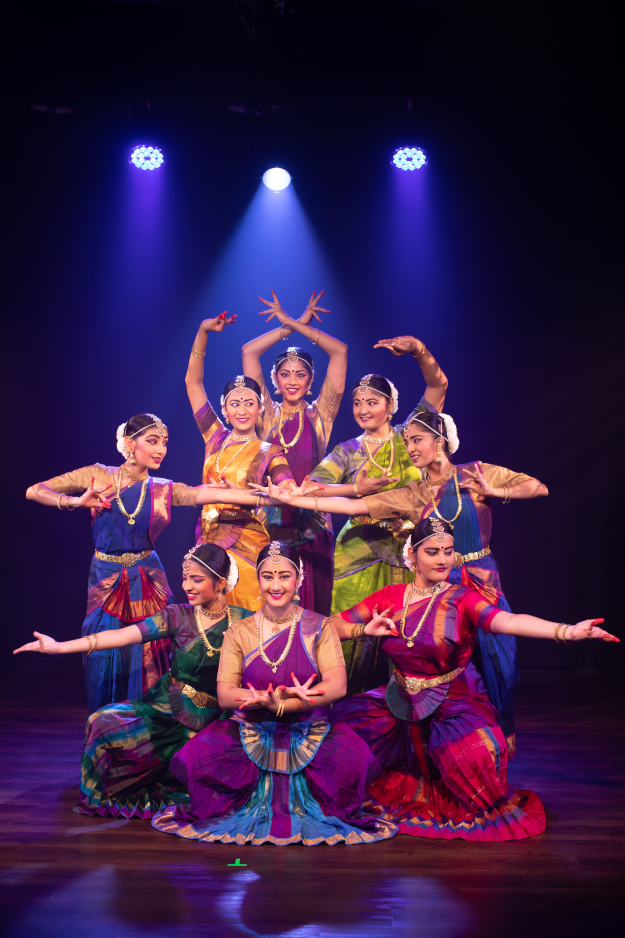
Apsaras Arts Academy provides meticulous dance training in the 3 genres of classical Indian dance – Bharatanatyam (Kalakshetra Bani), Kathak (Lucknow Gharana) and Odissi – for both children and adults. We also offer an introductory dance programme called Balabharatham for 4 to 6 year olds. As has been the case since 1977,
Apsaras Arts Academy students – of all ages – are exposed to as many “live audience” performances as possible. A critical component to fully understanding and mastering their chosen dance genre.
Not only are Apsaras Arts Academy faculty exponents of their craft, they are also gifted teachers who inspire a lifetime of commitment in their students.
Over the past decades, Apsaras Arts Academy graduates have established themselves as dancers and choreographers, setting-up teaching institutions in Singapore, Australia and USA. Our graduates also teach Bharatanatyam in educational institutions and community clubs in Singapore.



